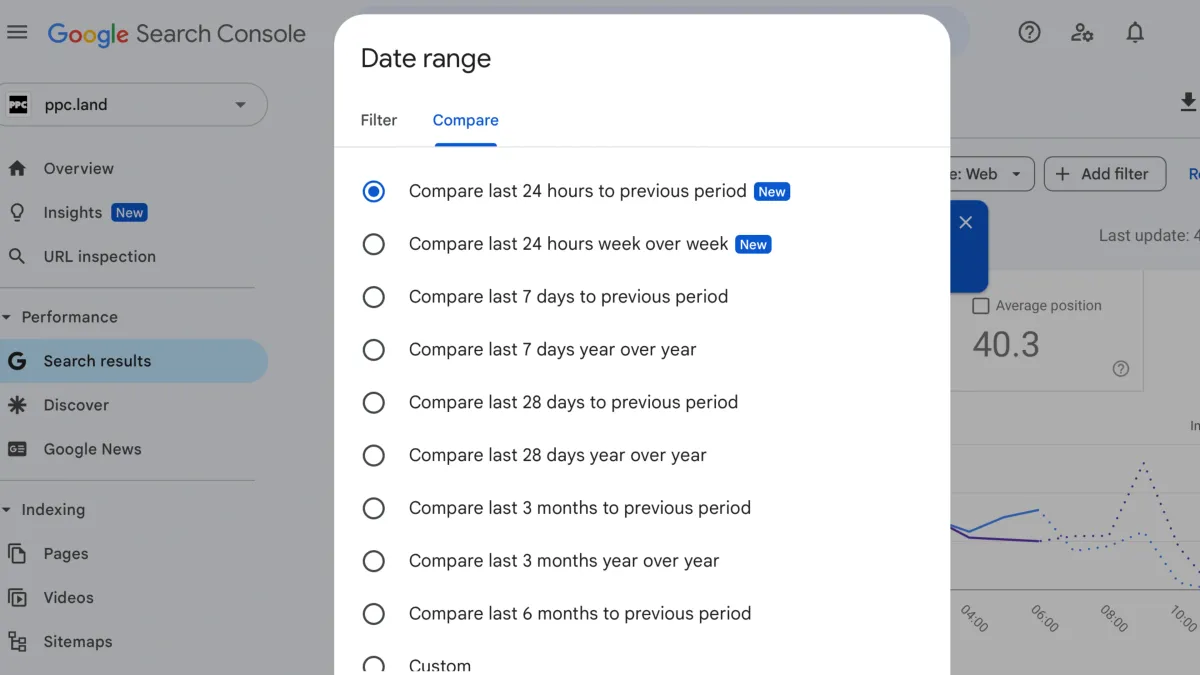



New Announcement: Google Search Console has introduced a new comparison mode within its 24-hour view, enabling website owners to analyse data almost in real-time. With search algorithms constantly evolving, this tool is essential for adapting swiftly to changes in user behaviour. The update enables businesses to compare various metrics quickly, ensuring that no opportunities are missed and potential vulnerabilities are promptly addressed. Discover how seamlessly this feature can fit into your SEO strategy.
The latest iteration of Google Search Console introduces a powerful comparison mode integrated directly into the 24-hour view. This feature enhances existing capabilities, allowing for a side-by-side analysis of website performance data with a level of granularity previously unavailable. Unlike traditional views that offer a broader, often delayed perspective, this new mode delivers near real-time insights, allowing businesses to identify and address issues almost as they arise. Imagine, for instance, a sudden drop in traffic following a website update. With the comparison mode, you can immediately pinpoint the cause by comparing performance metrics before and after the change, a task that would have historically taken hours or even days to accomplish. This aligns with the ongoing shift in SEO toward more immediate, data-driven decision-making.
The 24-hour view within Search Console provides a snapshot of your website's performance, updated with minimal delay. It's designed to surface immediate issues or opportunities that might otherwise be buried in day-old data. The relevance of adapting to real-time data for modern SEO strategies can't be overstated. Businesses that fail to monitor and respond to these immediate signals risk losing ground to competitors who are more agile. The 24-hour view provides businesses with a competitive edge, enabling them to identify and resolve website performance issues promptly.
The new comparison mode supercharges the existing 24-hour view in Google Search Console. It's not just about seeing what's happening now; it's about understanding why it's happening by juxtaposing current performance against a previous period. This feature surpasses standard performance checks, providing more in-depth insights. Instead of simply noting a traffic dip, you can directly compare hourly data from today with the same hours from yesterday or last week, instantly revealing patterns or anomalies that demand attention. For example, if you launched a new marketing campaign, the comparison mode allows you to see its immediate impact compared to a period before the launch. This allows for timely adjustments and optimises the campaign's effectiveness.
The comparison mode boasts several key functionalities that set it apart:
These features provide business users with immediate trend spotting, enabling proactive adaptation and optimisation. The new comparison mode provides a competitive advantage by enabling you to quickly identify and address any issues.
The comparison mode works by continuously collecting and processing data from Google's search index, then presenting it in an accessible, comparative format. Under the hood, algorithms analyse data streams in near real-time, organising them into hourly and daily aggregates. When you select a comparison period, the system retrieves the corresponding data and displays it alongside the current performance metrics, highlighting any significant differences. While the precise algorithms remain proprietary, it's crucial to understand that the accuracy depends on the completeness of Google's index and the consistency of your website's tracking setup. Users should ensure their Google Analytics and Search Console accounts are properly linked for the most reliable insights.
Leveraging the comparison mode unlocks several key benefits for businesses, each of which directly contributes to improved SEO performance and tangible business outcomes.
For instance, imagine a local e-commerce store notices a sudden dip in mobile traffic. Using the comparison mode, they quickly identify that a recent website update introduced a bug affecting mobile users. They immediately revert the update, preventing further revenue loss and maintaining a positive user experience. This demonstrates the mode's role in strategic planning and operational adjustments in SEO and marketing.
The comparison mode enables businesses to detect both positive and negative trends almost as they unfold. The ability to instantly identify anomalies is critical for preventing SEO issues or seizing fleeting opportunities. For example, if a local news story mentions your business, causing a surge in searches, the comparison mode will highlight this spike in real-time. You can then capitalise on this attention by adjusting your ad campaigns or creating targeted content.
Immediate data snapshots provided by the comparison mode accelerate the decision-making process. Consider a scenario where a restaurant notices a decline in searches for specific menu items during the lunchtime period. By comparing the current data with previous weeks, they realise that a competitor is offering a similar dish at a lower price. In response, they quickly adjust their pricing and promote the dish with a limited-time discount, effectively mitigating the competitive threat and maintaining their customer base. Accessing real-time comparative data saves both time and costs.
Accessing and utilising the comparison mode in Search Console is straightforward, designed to be accessible for users of all skill levels. Before you begin, ensure your Google Search Console account is properly set up and verified for your website.
Using the interface smoothly is crucial for effective tool usage.
The comparison mode interface is designed for intuitive navigation. Once you've activated the "Compare" option in the date range selector, the Performance report will visually split into two sections, each representing one of the selected time periods. Key metrics (clicks, impressions, CTR, average position) are displayed for both periods, with percentage changes indicating the difference between them. You can further refine your analysis by filtering the data based on specific queries, pages, countries, or devices. Hovering over the data points on the graphs provides detailed breakdowns for each period, allowing you to pinpoint the exact moments when performance shifts occurred.
Interpreting data from the comparison mode requires careful consideration. Avoid jumping to conclusions based solely on quantitative data; contextual analysis is crucial. Cross-reference data points with other analytics tools (like Google Analytics) to ensure accuracy and avoid misinterpretations. Also, remember that correlation does not imply causation; a sudden drop in traffic might coincide with a website change, but it could also be caused by external factors, such as a competitor's marketing campaign or a change in Google's algorithm. Look for patterns and trends across multiple metrics and time periods to form complete conclusions. A sharp increase in impressions with no corresponding increase in clicks, for example, might indicate an issue with your meta descriptions or page titles.
While powerful, the comparison mode can present certain challenges.
Understanding the tool's limitations while optimizing its functions is essential.
Several misconceptions surround the Search Console's 24-hour view:
The 24-hour view is best used as a dynamic tool rather than a static resource.
Potential pitfalls in data interpretation exist. One common error is focusing solely on percentage changes without considering the underlying numbers. A 50% increase in clicks might seem impressive, but if the initial number of clicks was only ten, the actual impact is minimal. Always consider the absolute values alongside the percentage changes. Another potential error is ignoring external factors that might influence the data. Stay informed about industry news, algorithm updates, and competitor activities to provide context for your analysis. Validating data interpretations requires cross-verification with other analytics tools. For instance, if you observe a decrease in organic traffic, check your Google Analytics data to see if it corresponds with a decrease in overall website traffic.
Examining real-life applications helps connect theory with practice. Let's explore how businesses have effectively employed the comparison mode to achieve tangible results. Each study includes context, strategy, results, and insights applicable to a wide audience.
Red Search, an award-winning SEO agency specializing in fast online growth, leveraged the comparison mode to refine SEO strategies for Simply Maid, helping them achieve top rankings on Google for major search terms across all major Australian states as of 2025. By using the Comparison Mode, Red Search was able to see the before and after effects of new updates that were made.
Paul’s Rubbish Removal experienced significant growth by leveraging the comparison mode. They achieved a 624% increase in organic traffic through focused link-building strategies demonstrating the power of focused SEO. Paul and his team could use the tool to monitor new links and see their effects in real-time. They focused on the metrics that mattered and grew a lead generation machine.
The comparison mode in Google Search Console is a vital tool for driving business growth in the current year. By integrating this feature into their SEO practice, businesses can expect long-term benefits, including improved website performance, increased organic traffic, and enhanced decision-making capabilities. As data analytics becomes increasingly critical, embracing technological advancements like the comparison mode is essential for maintaining a competitive edge. Businesses must adapt and evolve their SEO strategies to thrive in this dynamic landscape.
Here’s a clear list of actionable next steps:

We value your privacy
We use cookies to enhance your browsing experience, serve content, and analyse our traffic. By clicking "Accept All," you consent to our use of cookies. Cookie Policy

